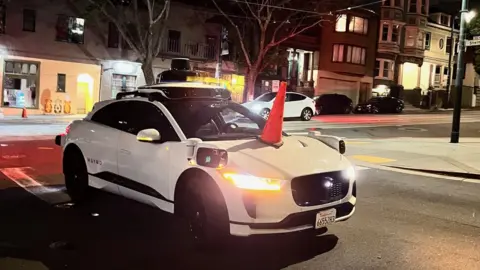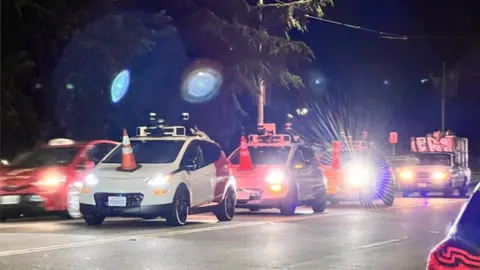How robotaxis are dividing San Francisco
 BBC
BBCMy heartbeat quickens just a little as the cab approaches. It's a bizarre sight, one that I thought I wouldn't see in my lifetime.
The cab has no driver. It stops in front of me and invites me to unlock its door with my phone - before whisking me into the night.
But as I am about to get in, a passer-by approaches.
"They're unsafe," he tells me. He says he saw someone nearly get run over by a robotaxi - and warns me to be careful.
He represents a faction in San Francisco that doesn't like robotaxis - and believes the city has agreed to a dangerous experiment, which is putting lives at risk.
And some have gone a step further. Over the summer a campaign group has begun to disable the cars, by putting cones on their bonnets.
Safe Street Rebel describes what it does as "coning" and some of its videos have gone viral. But city officials are committed to allowing them to operate on their streets - for now.

On 10 August 2023, the California Public Utilities Commission (CPUC) voted to allow two cab companies - Waymo and Cruise - to run a 24-hour service. Previously, they'd only been allowed to operate paid rides at night.
But before that vote, officials listened to six hours of public comment - a conveyor belt of people voicing their hopes and concerns.
There were Uber and Lyft drivers worried that robotaxis would take away their livelihoods: "If you allow self-driving taxis to expand, it's going to take jobs away from families. I'm a single mum," said Rosine, an Uber driver in the city.
Representatives of garbage disposal trucks said the cars often broke down and blocked their vehicles. San Francisco's fire service has criticised the cars for the same reason - claiming to have been obstructed 55 times this year.
Others believe the technology simply hasn't proved itself to be safe yet. Matthew Sutter, a cab driver in San Francisco, said: "I'm all about technology, but it's not ready guys... this is a danger to the citizens of San Francisco."
There were others representing physically disabled people who wondered how they would be able to get into cabs without help from a driver. Mara Math, a member of the Paratransit Coordinating Council, said the embrace of robotaxis would "leave disabled San Franciscans out in the cold".
But then there were its supporters. George Janku, an orthopaedic surgeon in San Francisco and keen cyclist, said: "I see how these cars behave, and I trust them much more than angry drivers or distracted drivers." He added that he had worked on many serious injuries involving human drivers - and that robotaxis appear to be safer.
Jessie Wolinsky, who is blind, said she had been harassed by Uber and Lyft drivers. Waymo cars had "provided me with a level of safety that I've never experienced before".
There was also a mother who said taxi drivers had rejected her when they saw her children's car seats - something a driverless car would never do.
I have seen both sides of the argument. I have used Cruise's robotaxis several times over the last few months, without any accidents. At the same time, I have also been in a robotaxi that has broken down in the middle of the street.
Unsure how to handle a tight right-hand turn, it simply stopped. Cars behind me beeped and then finally mounted the kerb to get around us. I could understand their frustration.
Just eight days after the vote to allow companies to expand the use of robotaxis, a Cruise taxi was involved in an accident with a fire engine.
Allow X content?
The state department of motor vehicles requested that Cruise halve the number of vehicles on the roads - something it has agreed to.
The city's Attorney, David Chiu, asked the CPUC to halt its decision: "San Francisco will suffer serious harms from this unfettered expansion," he said.
And yet Cruise and Waymo are insistent that their robotaxis are safe.
Waymo told the BBC the company had clocked more than two million miles of fully autonomous driving. It says it has not had a single accident with a pedestrian or cyclist.
Waymo also says that every vehicle-to-vehicle collision it has been involved in is when other drivers break the rules or drive dangerously.
Cruise told the BBC it had completed three million driverless miles and had a strong safety record.
Many San Franciscans remain unconvinced though. In a quiet city park I met one of the ringleaders of Safe Street Rebel - who wishes to be anonymous.
They tell me that coning may be one of the first physical protests against artificial intelligence - and that these kinds of human actions are going to become more and more common.

They're frustrated that people's concerns about robotaxis in San Francisco are not being listened to: "We're definitely not vigilantes. We're just the community self-organising to make ourselves heard."
I asked them whether they were the 21st Century equivalent of a Luddite - a group that was vehemently opposed to technological changes in the early 19th Century.
"Yeah, I think there are parallels here. And I think the Luddites get treated unfairly throughout history."

San Francisco is in a strange place. It wants to be at the spearhead of innovation. But city officials have not taken many residents with them.
It now feels like the city has reached a crossroads. The car companies themselves insist the vehicles are safe. But if they can't convince San Franciscans of that, they will have a fight on their hands to remain on the city's streets.
